Here at CIMI, we’re seeing red! We’ve had two sudden invasions of bright red, shimmery, buoyant things just offshore in our coves. The first is pelagic red crabs, Pleuroncodes planipes, that swarmed northward from warmer waters as El Niño brought an unseasonable winter to the tropics. Can you guess what the second is? Just a few days after Valentine’s Day, heart-shaped Mylar balloons are showing up everywhere! Unfortunately, a gift to surprise a sweetheart for just one day can take many years to degrade in the ocean. So how long do other household objects take to break down in the sea? Check out the charts below.
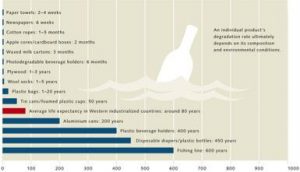
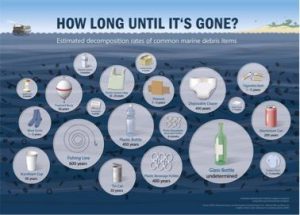
TRASH TIMELINES
Image Credit: World Ocean Review (http://worldoceanreview.com/en/wor-1/pollution/litter/); NOAA (http://thehigherlearning.com)
As you can see, oil-based products take by far the longest to degrade, with fishing line, plastic bottles, and 6-pack plastic rings predicted to take as long as 600 years to break down fully. Keep in mind, we’ve only been using plastic for about 100 years at all!
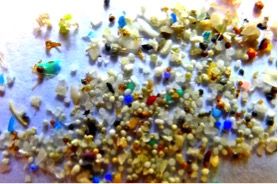 Microplastics, Mega Problem!
Microplastics, Mega Problem!
Once these plastics are subjected to prolonged sunlight, waves, currents and tides, they are broken into tiny fragments thinner than a human hair, called microplastics. Being so small, these particles can easily enter the food chain through filter feeders such as shellfish. Many cosmetics companies also put small beads of plastic in products such as exfoliating soaps, until recent research reported that enough of these microbeads to coat 300 tennis courts were entering watersheds and oceans daily. These findings, combined with more recent research spotlighting the harmful effects of accumulation of microplastics in sediment, the water column, and the tissues and bodily fluids of marine animals, has led President Obama to sign a microbead ban, preventing these companies from using this ‘indestructible confetti’ in their products. Many plastics contain chemicals such as solvents and softeners, and could cause severe poisoning effects in marine food webs, including humans.
 MICROPLASTICS & MICROBEADS
MICROPLASTICS & MICROBEADS
Image Credit: ecowatch.org
A Gyre Situation
Due to large-scale circular wind and current patterns called gyres, much of the ocean’s trash ends up concentrated in specific places. The largest of these is a giant “soup” of trash in the Pacific Ocean northwest of Hawaii, known as the “Great Pacific Garbage Patch” (GPGP) or the “Pacific trash vortex.” A great majority of this trash is actually tiny micro plastics, making the water look cloudy in satellite imagery. Many of the larger items, including sneakers, electronics, and larger plastic items, may have sunk underneath the Texas-sized floating island.
PACIFIC PATCHES AND GYRES
Image Credit: NOAA (http://marinedebris.noaa.gov)
Creative Clean Up
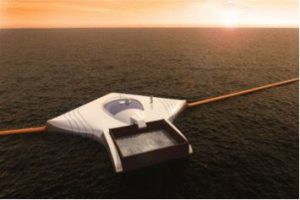 Since the GPGP is so large and so far from any nation’s borders, no one government is willing or able to provide the funding and labor needed to clean it up. However, the scale of the problem has inspired many organizations and individuals to launch expeditions and brainstorm creative ideas for cleaning it up or preventing it from growing. Boyan Slat, a crafty 19-year-old from Holland, is currently collaborating with aerospace engineers to design a floating robot to collect the larger pieces of trash, while others propose introducing plastic-eating bacteria or other marine microbes to begin to break down the plastics of all sizes. In 2010, a team of explorers at Adventure Ecology built a 60-foot catamaran called the Plastiki using 12,500 recycled plastic bottles. The Plastiki‘s crew voyaged from California to Australia to raise awareness about the durability, usefulness, and permanence of used plastic products.
Since the GPGP is so large and so far from any nation’s borders, no one government is willing or able to provide the funding and labor needed to clean it up. However, the scale of the problem has inspired many organizations and individuals to launch expeditions and brainstorm creative ideas for cleaning it up or preventing it from growing. Boyan Slat, a crafty 19-year-old from Holland, is currently collaborating with aerospace engineers to design a floating robot to collect the larger pieces of trash, while others propose introducing plastic-eating bacteria or other marine microbes to begin to break down the plastics of all sizes. In 2010, a team of explorers at Adventure Ecology built a 60-foot catamaran called the Plastiki using 12,500 recycled plastic bottles. The Plastiki‘s crew voyaged from California to Australia to raise awareness about the durability, usefulness, and permanence of used plastic products.
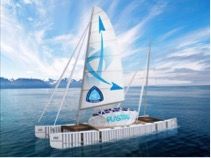 BOYAN SLAT’S BIG IDEA
BOYAN SLAT’S BIG IDEA
Image Credit: The Ocean Cleanup (see link below)
THE PLASTIKI’S DESIGN
Image Credit: Australian Museum Blog (http://australianmuseum.net.au/blogpost/science/plastiki-a-solution-to-waste)
Be an Ocean Hero!
Here are some easy ways you can be an ocean hero and make sure our trash doesn’t outlive us!
- Reduce, reuse, recycle, especially plastic products!
- Take a reusable bag to the store instead of getting plastic grocery bags…
- and if you do, reuse them for something in your home like trash bags!
- Pick up trash you see on beaches, streets, and in waterways — but don’t forget to wash your hands afterwards!
- If you go fishing, make sure you pack out all the gear you packed in — especially nets and lines!
- Cut the rings on plastic can holders before you discard them so wildlife can’t get stuck in the openings!
- Look for cosmetics with natural alternatives to microbeads!
and finally, on Valentine’s Day, birthdays, and other special occasions…
- Skip the Mylar balloons, and SAY IT WITH CHOCOLATE! We’re not sure about you, but around here, it’s gone in about three seconds!
Want to learn more about microbeads? Check out the Story of Stuff’s website at http://storyofstuff.org/plastic-microbeads-ban-the-bead/.
To learn more about current estimates of quantities of trash in the ocean, and see an awesome 3D animation of how plastics break down in detail, check out National Geographic’s story here: http://news.nationalgeographic.com/news/2015/01/150109-oceans-plastic-sea-trash-science-marine-debris/.
To learn more about the Great Pacific Garbage Patch and play with an interactive map of other places trash converges, check out http://education.nationalgeographic.org/encyclopedia/great-pacific-garbage-patch/.
To learn about Boyan Slat’s cleanup robot design, check out this story on TakePart: http://www.takepart.com/article/2014/06/12/ocean-clean-machine-invented-19-year-old-could-pick-half-pacific-garbage-patch.
To learn more about the voyage of the Plastiki, check out Adventure Ecology’s website at http://theplastiki.com.


